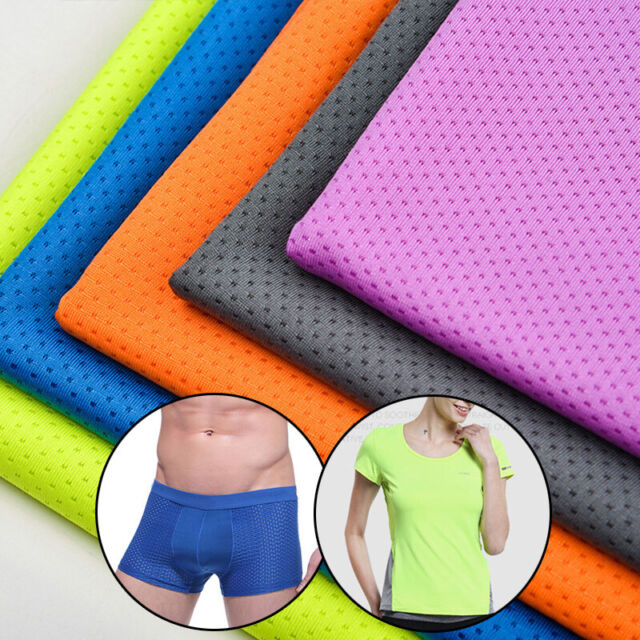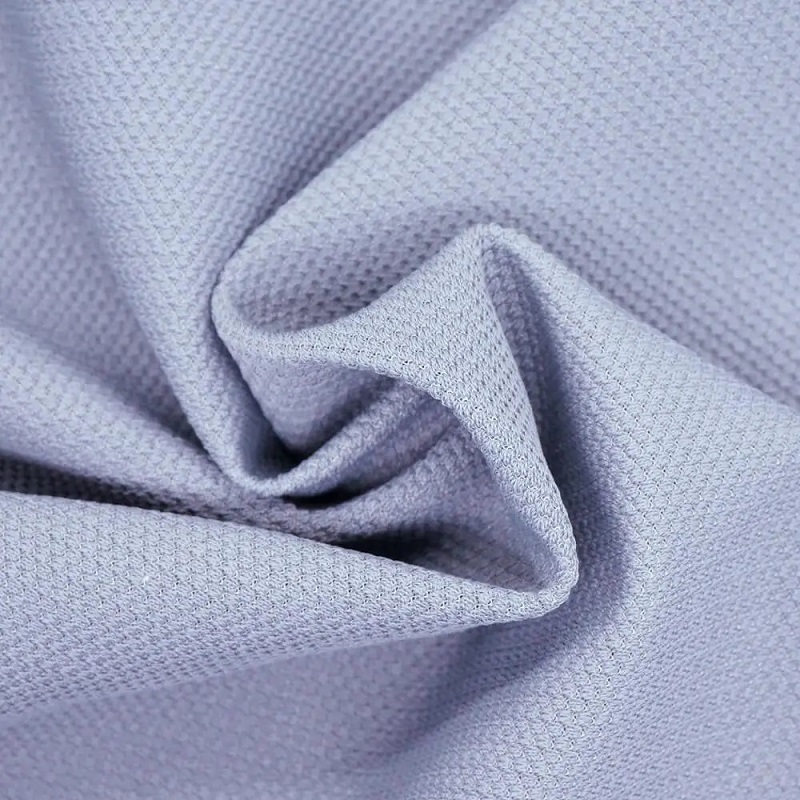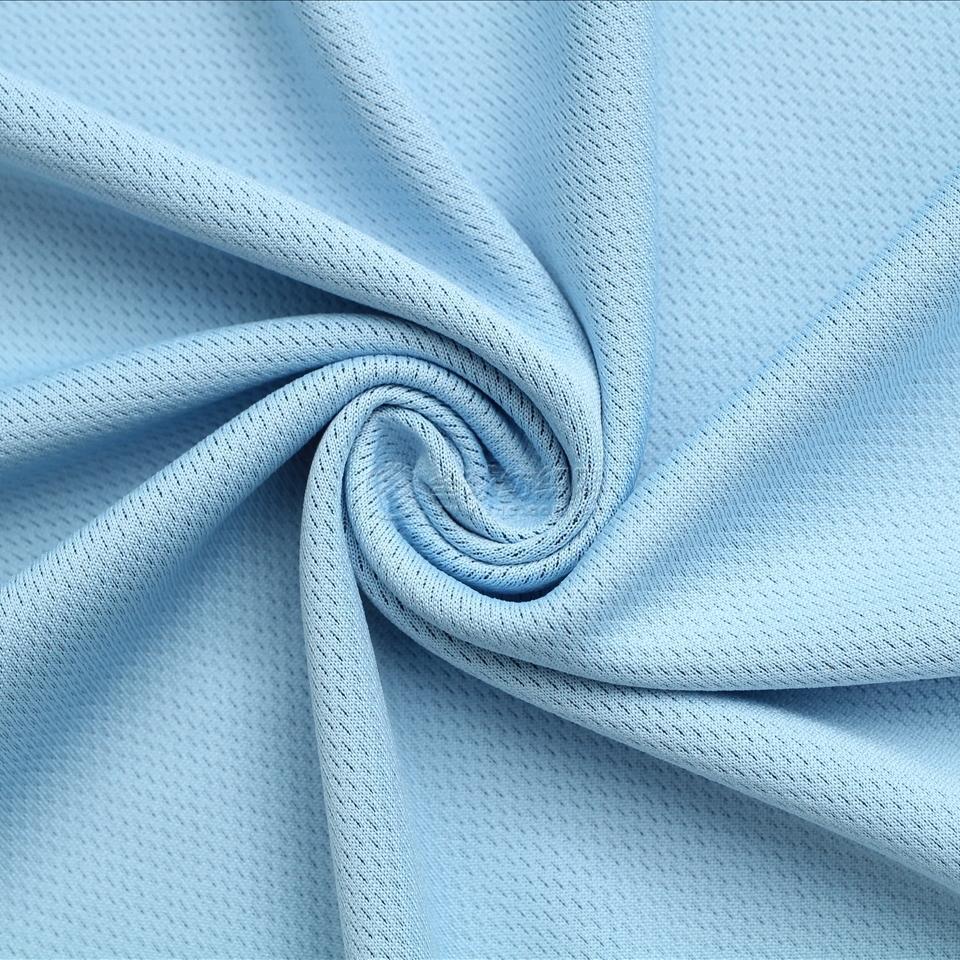The Benefits of Using Sport Jersey Fabric for Athletic Wear
Athletic wear plays a crucial role in enhancing performance and comfort during sports activities. One of the key elements that contribute to the functionality and durability of such garments is the fabric used in their construction. When it comes to crafting high-quality athletic wear, sport jersey fabric emerges as a top choice. In this section, we will explore the numerous benefits of using sport jersey fabric for athletic wear.
1. Moisture Management
One of the primary advantages of sport jersey fabric is its exceptional moisture-wicking properties. During intense physical activities, athletes perspire, and the fabric’s ability to draw moisture away from the skin helps to keep them dry and comfortable. Sport jersey fabric is often made from synthetic fibers such as polyester or nylon, which possess inherent moisture-wicking capabilities. This feature allows athletes to focus on their performance without being distracted by sweat-soaked clothing.
2. Breathability
Proper ventilation is crucial for athletes, as it helps regulate body temperature and prevents overheating. Sport jersey fabric facilitates excellent air circulation due to its unique construction. It typically features a knit or mesh structure that allows air to flow freely through the garment, promoting breathability. The breathable nature of sport jersey fabric prevents the buildup of excessive heat and moisture, ensuring athletes stay cool and comfortable during intense workouts or competitions.
3. Flexibility and Stretch
Athletic activities often require a wide range of motion, and sport jersey fabric is designed to accommodate these movements. The fabric’s elasticity and stretchiness allow it to conform to the body’s contours without restricting mobility. This flexibility is particularly important in sports that involve a lot of running, jumping, or stretching. With sport jersey fabric, athletes can move freely without feeling constrained, enhancing their performance and reducing the risk of injury.
4. Durability
Athletic wear is subjected to intense physical stress, making durability a key consideration. Sport jersey fabric is known for its strength and resilience, making it suitable for rigorous sporting activities. The fabric’s composition and construction ensure that it can withstand repeated use and frequent washing without losing its shape or integrity. This durability factor makes sport jersey fabric a wise investment for athletes, as it ensures that their garments will last through countless workouts and competitions.
5. Easy Care and Maintenance
In addition to its performance benefits, sport jersey fabric offers the advantage of easy care and maintenance. Athletes often have demanding training schedules, leaving them with limited time for garment upkeep. Sport jersey fabric is typically machine washable and quick-drying, allowing for convenient cleaning between uses. Its resistance to wrinkles and shrinkage further simplifies the maintenance process, ensuring that athletes can focus on their training rather than worrying about garment care.
How to Choose the Right Sport Jersey Fabric for Your Project
Now that we have explored the benefits of sport jersey fabric, it is essential to understand how to select the right fabric for your specific athletic wear project. Consider the following factors when choosing sport jersey fabric:
1. Activity and Intensity Level
Different sports and activities have varying demands on athletic wear. Consider the specific requirements of your chosen activity, such as the level of impact, duration, and environmental conditions. For high-intensity sports like basketball or soccer, opt for sport jersey fabric with excellent moisture-wicking and breathability properties. For low-impact activities like yoga or pilates, a softer and more lightweight sport jersey fabric may be more suitable.
2. Fabric Composition
Sport jersey fabric is available in various compositions, with synthetic fibers like polyester and nylon being the most common. These synthetic materials offer excellent moisture management and durability. However, natural fibers like cotton can also be used, although they may not possess the same level of moisture-wicking capabilities. Consider your preferences and the specific performance requirements when selecting the fabric composition.
3. Stretch and Recovery
Since athletic activities involve a wide range of motion, it is crucial to choose a sport jersey fabric that offers sufficient stretch and recovery. Look for fabrics with good elasticity and a high percentage of stretch fibers like spandex or elastane. These fibers allow the fabric to stretch without losing its shape, ensuring optimal comfort and freedom of movement during physical activities.
4. Weight and Thickness
The weight and thickness of sport jersey fabric can significantly impact its performance. Lightweight fabrics are ideal for activities that require agility and breathability, while heavier fabrics provide more insulation and may be suitable for cooler environments. Consider the climate and conditions in which the athletic wear will be used, and choose the weight and thickness of the fabric accordingly.
5. Quality and Brand Reputation
When it comes to selecting sport jersey fabric, it is essential to prioritize quality and choose reputable brands or suppliers. High-quality fabric ensures longevity, durability, and optimal performance. Read reviews, seek recommendations, and inquire about the fabric’s source and manufacturing processes. Investing in trusted brands or suppliers with a reputation for delivering top-notch sport jersey fabric will ensure that your athletic wear project meets the highest standards.
Designing and Sewing with Sport Jersey Fabric
Once you have chosen the appropriate sport jersey fabric for your athletic wear project, it’s time to dive into the process of designing and sewing. Working with sport jersey fabric requires some specific considerations to ensure the best results. Here are some tips and tricks to help you navigate the design and sewing process:
1. Preparing the Fabric
Before you start cutting and sewing, it’s essential to prepare the sport jersey fabric properly. Begin by washing and drying the fabric according to the manufacturer’s instructions. This step helps to eliminate any residual chemicals or finishes and pre-shrinks the fabric, preventing unwanted shrinkage after the garment is complete.
2. Pattern Selection
When choosing a pattern for your athletic wear, opt for designs specifically tailored for stretch fabrics or sportswear. These patterns are engineered to accommodate the unique characteristics of sport jersey fabric, such as its stretch and recovery properties. Look for patterns that offer options for different garment lengths, sleeve variations, and specialized features like mesh inserts or ventilated panels, depending on your specific design preferences.
3. Cutting Techniques
Sport jersey fabric can be prone to stretching and shifting during the cutting process due to its inherent stretchiness. To minimize distortion, use sharp fabric scissors or a rotary cutter to ensure clean and precise cuts. Consider using pattern weights instead of pins when laying out your pattern pieces, as pins can leave permanent holes or cause the fabric to stretch. If you prefer using pins, insert them within the seam allowance to minimize the risk of visible holes or snags in the fabric.
4. Seam Construction
When sewing sport jersey fabric, it’s crucial to choose appropriate seam construction techniques that maintain the fabric’s stretch and flexibility. One commonly used method is the stretch stitch or a narrow zigzag stitch, which allows the seam to stretch along with the fabric. Another option is using a serger or overlock machine to create durable and stretchy seams with finished edges.
5. Seam Finishes
To prevent fraying and enhance the durability of your athletic wear, consider finishing the raw edges of the fabric. You can use techniques such as zigzag stitching, overcasting, or using a serger to enclose the raw edges. These finishes not only provide a clean and professional look but also help the garment withstand the rigors of frequent use and washing.
6. Elastic and Closures
Sport jersey fabric often requires the use of elastic or closures to ensure a secure and comfortable fit. When incorporating elastic into your design, choose high-quality elastic that offers good stretch and recovery. Consider using fold-over elastic or clear elastic for a more seamless and discreet finish. For closures like zippers or snaps, select those specifically designed for stretch fabrics to ensure they can withstand the fabric’s movement and stretching.
7. Testing and Adjusting
Since sport jersey fabric can behave differently depending on its composition and stretch, it’s crucial to test your sewing techniques and adjustments on scraps or muslin fabric before working on your final garment. This allows you to make any necessary modifications to the fit, stitch tension, or seam construction before committing to the sport jersey fabric.
Tips and Tricks for Proper Care and Maintenance of Sport Jersey Fabric
To maximize the lifespan and performance of your athletic wear made from sport jersey fabric, it’s essential to follow proper care and maintenance practices. Here are some tips and tricks to keep your sport jersey garments in optimal condition:
1. Follow Manufacturer’s Instructions
Always adhere to the specific care instructions provided by the fabric manufacturer or the pattern designer. These instructions often include recommendations for washing temperature, detergent type, and drying methods. Following these guidelines helps preserve the fabric’s integrity and prevent any unnecessary damage or shrinkage.
2. Machine Washing
Sport jersey fabric is typically machine washable, but it’s essential to use a gentle cycle with cold or lukewarm water. Avoid using harsh detergents or bleach, as they can degrade the fabric’s performance and color. If possible, turn the garment inside out before washing to minimize friction and prevent pilling or snagging.
3. Drying Methods
Air-drying is the preferred method for drying sport jersey garments. Lay the garment flat on a clean towel or a drying rack to maintain its shape and prevent stretching. Avoid wringing or twisting the fabric, as this can cause it to lose its elasticity. If you use a dryer, select a low heat setting and remove the garment promptly to prevent over-drying.
4. Avoiding High Heat
Sport jersey fabric is sensitive to high heat, which can damage its stretch and recovery properties. Avoid ironing the fabric at high temperatures, as it can cause the fibers to melt or warp. If ironing is necessary, use a low heat setting or place a pressing cloth between the fabric and the iron to protect it.
5. Storage
When storing your sport jersey garments, ensure they are clean and completely dry to prevent the growth of mold or mildew. Fold the garments neatly and store themin a cool, dry place away from direct sunlight. Avoid hanging the garments for extended periods, as this can cause stretching and distortion over time.
6. Spot Cleaning
For small stains or spills, it’s best to spot clean the affected area immediately. Use a mild detergent or stain remover specifically formulated for delicate fabrics. Gently blot the stain with a clean cloth or sponge, being careful not to rub or scrub vigorously, as this can damage the fabric.
7. Avoiding Abrasive Surfaces
During use and storage, be mindful of surfaces that could potentially snag or abrade the sport jersey fabric. Avoid rough or textured surfaces that may cause pilling or snags. Additionally, be cautious when wearing jewelry or accessories that could catch on the fabric and cause damage.
8. Regular Inspections
Periodically inspect your sport jersey garments for any signs of wear, such as stretched seams, loose threads, or fabric thinning. Address any issues promptly to prevent further damage and ensure the longevity of your garments. Reinforce seams, trim loose threads, or consider patching small areas that show signs of wear and tear.
By following these tips and tricks for proper care and maintenance, you can extend the life of your sport jersey garments and keep them looking and performing their best for a long time.
Case Studies: Successful Uses of Sport Jersey Fabric in Sportswear Design
Sport jersey fabric has gained significant popularity in the textile industry due to its unique properties and versatility. Here are a few case studies highlighting successful uses of sport jersey fabric in sportswear design:
1. Nike Dri-FIT Technology
Nike’s Dri-FIT technology revolutionized the sportswear industry by incorporating sport jersey fabric with moisture-wicking properties. The fabric is designed to draw sweat away from the body, keeping athletes dry and comfortable during intense physical activities. This technology has been widely used in various sports apparel, including jerseys, shorts, and leggings, providing athletes with enhanced performance and moisture management.
2. Under Armour HeatGear
Under Armour introduced HeatGear, a line of sportswear made from sport jersey fabric specifically engineered to keep athletes cool and dry in hot weather conditions. The fabric’s lightweight and breathable nature allow for excellent ventilation and moisture evaporation, making it ideal for activities like running, soccer, and tennis. Under Armour’s HeatGear garments have become popular among athletes seeking optimal comfort and performance in warm climates.
3. Adidas TechFit
Adidas incorporated sport jersey fabric into its TechFit line, which focuses on compression garments for various sports. The fabric’s stretch and recovery properties provide a snug and supportive fit, enhancing muscle awareness and reducing muscle fatigue. TechFit garments made from sport jersey fabric have gained popularity among athletes looking for improved performance, reduced muscle vibration, and enhanced recovery during intensive training sessions.
4. Lululemon Athletica
Lululemon Athletica, a well-known brand in the activewear industry, utilizes sport jersey fabric in their leggings and tops. The fabric’s four-way stretch capability offers excellent flexibility and freedom of movement, making it suitable for activities like yoga, Pilates, and gym workouts. Lululemon’s use of sport jersey fabric has contributed to the brand’s reputation for producing high-quality, comfortable, and fashionable activewear.
These case studies demonstrate the successful integration of sport jersey fabric in sportswear design. The fabric’s moisture-wicking properties, breathability, stretch, and recovery characteristics have allowed brands to create innovative and performance-enhancing garments that meet the evolving needs of athletes.
Conclusion: The Future of Sport Jersey Fabric in the Textile Industry
Sport jersey fabric has become a staple in the textile industry, catering to the growing demand for high-performance and comfortable sportswear. As the industry continues to evolve, the future of sport jersey fabric looks promising. Here are a few key trends and developments to expect:
1. Sustainable Innovations
With increasing awareness of environmental concerns, the textile industry is placing greater emphasis on sustainability. In the future, sport jersey fabric is likely to witness advancements in eco-friendly manufacturing processes, the use of recycled materials, and the development of biodegradable fibers. These efforts will contribute to reducing the environmental impact of sportswear production while maintaining the fabric’s performance and quality.
2. Smart Textiles Integration
The integration of technology and textiles, known as smart textiles, is an area of ongoing research and development. Sport jersey fabric can serve as an excellent base for incorporating smart features such as moisture sensors, temperature regulation, and biometric monitoring directly into the fabric. This integration will allow athletes to gather valuable data and enhance their performance and well-being during sports activities.
3. Customization and Personalization
As consumers seek unique and personalized products, the future of sport jersey fabric will likely include advancements in customization. This could involve the development of technologies that allow individuals to design and personalize their sportswear, including choosing specific patterns, colors, and even incorporating personalized logos or graphics on the fabric.
4. Performance Enhancements
Sport jersey fabric will continue to be refined to provide even better performance enhancements. This may include improvements in moisture management, breathability, durability, and stretch and recovery properties. Manufacturers will strive to create fabrics that offer superior comfort, support, and mobility to athletes across various sports and activities.
In summary, the future of sport jersey fabric in the textile industry will be characterized by sustainability, smart textile integration, customization, and ongoing advancements in performance-enhancing properties. As designers and manufacturers push the boundaries of fabric technology, athletes and consumers can look forward to even more innovative and high-performing sportswear options in the years to come.




